Armored recovery vehicle Bergepanzer 38 (t), Germany
The command decided that units equipped with Hetzer self-propelled guns required armored repair and recovery vehicles (BREM). The main task of this technology was to be the evacuation of damaged self-propelled guns from the battlefield. In addition, they were planned to be used as a mobile workshop, necessary for the repair of damaged armored vehicles. Such requirements determined the composition of the necessary special equipment. In addition, for reasons of economy, it was decided to build BREM on the basis of the existing Jagdpanzer 38 chassis. With such a unification, it was possible to significantly simplify the production and operation of two types of equipment through the use of common components, as well as by simplifying the supply of spare parts and maintenance.
The development of a new armored car, which was another option for the development of the lung tank Pz.Kpfw. 38 (t) was again entrusted to the company Böhmisch-Mährische Maschinenfabrik AG. This organization previously created a base tank, and then for a long time was engaged in its development and adaptation to new special tasks.
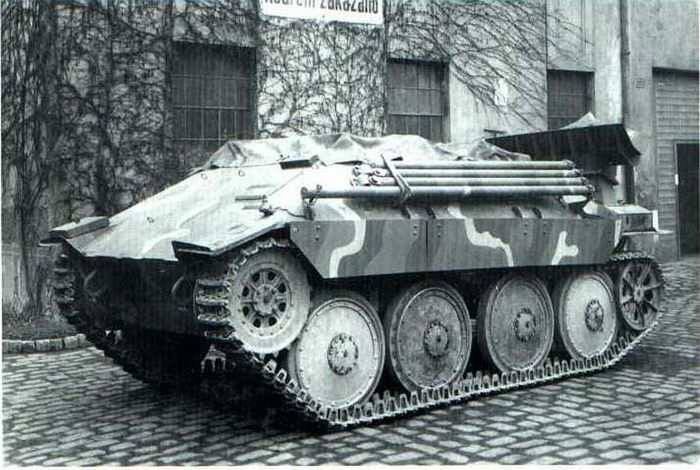
General view of the Bergepanzer 38 (t). Photo 2iemeguerre.ca
The proposal to use the existing chassis also greatly simplified the creation of a new repair and recovery vehicle. It was possible to slightly modify the existing hull, remove some more unnecessary units and install new equipment, as well as use ready-made powerplant and undercarriage. In addition, in the future, such a technique of developing new technology promised to reduce the cost of building new BREM.
For the new Bergepanzer BREM 38 (t), an updated armored corps was developed, based on the existing design, created earlier for self-propelled guns. The lower part of the hull had a box-like shape associated with the need to mount the elements of the power plant and the chassis. The upper part of the hull, in turn, was made of several armor plates of various shapes and sizes, mounted with a slope inward. It was also decided to reduce the height of the deckhouse, as well as abandon the roof due to the need to solve some new problems.
Repair and recovery vehicle received a new inclined front sheet with a thickness of 60 mm. In contrast to the basic design, it was now proposed to use a solid armor piece without a large embrasure, intended for mounting the gun. On the left side of the frontal sheet, there was a hatch with viewing devices of the driver, but due to the reduction in the height of the body, it was now almost under the upper forehead cut. Inclined sides and hull roof was proposed to be made from 20-mm sheets. The roof was not provided, and the bottom was 10 mm thick.
The main features of the layout of the hull were retained, although the change in the class of the armored vehicle affected the composition of the units. In front of the hull there was a transmission, behind which was placed a large habitable compartment, inside which the seats of all crew members were to be placed. Also in the central compartment it was proposed to mount some special equipment. The aft compartment of the hull was given under the engine.
BREM Bergepanzer 38 (t) was to be equipped with a Praga AC petrol engine with a capacity of at least 150 hp. Next to the engine in the stern compartment of the hull were two fuel tanks with a total capacity of 320 l. Through the multi-disc main clutch and drive shaft, passing over the bottom of the case, the engine torque was fed to the five-speed planetary gearbox. Then the moment passed through the turning mechanism and onboard gears.
Without any changes from the previous project, the tracked undercarriage with front drive wheels was borrowed. The armored vehicle received four large diameter ice rinks on board. The rollers were blocked in pairs, each such “trolley” received its own sheet shock absorber. The tensioning mechanism of the track with the guide wheel was placed in the rear part of the hull. There were also several pairs of support rollers.
To solve its main tasks, an armored repair and recovery vehicle Bergepanzer 38 (t) had to carry a set of special equipment, tools, etc. It should be noted that different serial samples of such equipment differed in the specific composition of the equipment. Machines of some series received one system, while other parties had different equipment. As a result, formally the same type of BREM had noticeable differences in appearance, in the functions performed and in the characteristics. Consider all the options for special equipment, proposed for installation on machines of different series.
The main objective of BREM was towing damaged cars and their evacuation from the battlefield. For these purposes, it was proposed to use towing devices that could be operated both with a rigid coupling and with cables of adequate strength. In addition, for pulling stuck machines of low mass it was possible to use a winch with a pulling force at the level of 2 tf. In the future, the project introduced a more powerful five-ton winch. Also, there are references to the release of a certain number of armored vehicles with a winch that developed an effort up to 10 tf. In all cases, the winch was installed at the right side of the stern of the habitable compartment, and the issuance of the cable was made through a window in an inclined stern sheet.
The project also envisaged the use of a crane of appropriate characteristics. In this case, different series of Bergepanzer 38 (t) received cranes slightly different designs. The machine carried a mast crane collapsible design. On a special mount case should install a set of beams and racks, forming a rigid structure that distributes the weight of the load on the armored case. One of the beams became an arrow and had to hold the cable with a load hook. For lifting loads it was proposed to use an existing winch or other equipment. The design of the collapsible mast crane allowed loading operations with the boom forward relative to the machine. For transportation, the crane was disassembled, and its beams were laid on the fixings of the hull sides.
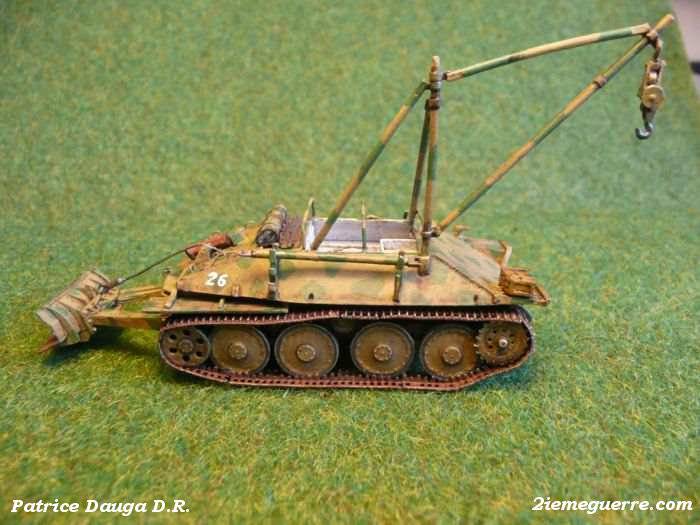
Model BREM Bergepanzer 38 (t). Visible crane design. Photo 2iemeguerre.ca
In the course of serial construction of repair and recovery vehicles, a slight modernization of the crane was carried out, mainly consisting in strengthening its beams and their fastenings in order to slightly increase the load capacity. The main features of its design, however, remained unchanged.
Another attribute of a significant number of BREMs based on the Jagdpanzer 38 was the opener, which could be used when towing or pulling machinery, as well as during crane operation. The opener of the curved profile was attached to the V-shaped structure of the beams, which were attached to the aft of the hull. Before doing the work, it should be lowered to the ground and secured, giving back a little. In the transport position, the vomer rose upwards, while its beams occupied a vertical position. Because of the large mass, the coulter had to lower and rise with the help of a standard machine winch.
Inside the habitable compartment and on the external fixings of the hull, the repair and recovery vehicle had to carry the tools necessary for work, some spare parts, crane elements, etc. Due to this, the crew was able in the field to carry out a significant number of operations and procedures for evacuation and minor repair of equipment.
As an auxiliary machine, the Bergepanzer 38 (t) repair and recovery vehicle did not have serious weapons. For self-defense, one MG 7,92 or MG 34 42-mm machine gun should have been used. Depending on the parameters of a particular machine, the machine gun had to be transported in a piling or mounted on a pivot installation. The available weapons made it possible to defend against the enemy’s infantry and to cover the crew members working on evacuation equipment.
The crew of the new BREM was to consist of four people. In front of the habitable compartment, at the control post, a driver was placed. Behind him should have been the seats of the other crew members who were responsible for the operation of special equipment and the performance of basic tasks. Depending on the current situation and the available goals, they could work without leaving the car, or being outside the protected building. For communication, the crew had one FuG 5 radio station.
Due to the absence of fundamental modifications of the hull in comparison with the base SAU, the new BREM retained its dimensions. The length of the machine (along the hull, excluding the coulter) was 4,87 m, width - 2,63 m, height - 1,7 m. The combat weight was 14,5 t. Some reduction in the combat weight did not lead to a significant change in mobility. The maximum speed reached 42 km / h, power reserve - 177 km.
The development of the Bergepanzer 38 (t) project was completed by the middle of 1944. Soon after, the first prototype was assembled, based on the verification of which it was decided to further mass production of new equipment with the subsequent transfer of vehicles to the troops. At this time, the needs of artillery units were identified. Examination of the question by experts of the Wehrmacht showed that the troops needed one repair and recovery vehicle for every 14 self-propelled artillery. Looking ahead, it should be noted that until the end of the war, German industry built less 2900 SAU Jagdpanzer 38. Thus, in total (taking into account the entire serial construction), the troops could require at least two hundred new BREM. Most of these needs were met.
By the beginning of autumn 1944, Böhmisch-Mährische Maschinenfabrik AG had built the first seven cars of the new type. According to some reports, this technique was built on the basis of a specially assembled tracked chassis. Soon, the manufacturer has mastered the full-fledged production of the required equipment, and part of the BREM was made from scratch, and the rest were proposed to be rebuilt from self-propelled guns returned to the rear for repair. From time to time the features of the production of new technology changed. In particular, some or other adjustments were made to the design of special equipment, as well as its composition. It is known that not all BREM received a feed opener, and the winch power varied within fairly wide limits. There is also information about the release of a certain number of cars with frontal armor with a thickness of only 30 mm - half as much as was envisaged by the original project.
The assembly of armored repair and recovery vehicles continued until April 1945, and ceased simultaneously with the construction of an ACS Jagdpanzer 38 Hetzer. The offensive of the Red Army on the Eastern Front led to the loss of one military plant after another, which eventually led to the cessation of the production of a mass of samples weapons and equipment, including self-propelled guns and other equipment based on Pz.Kpfw.38 (t).
According to reports, until April, 1945-th plant BMM managed to release a total of 170 machines Bergepanzer 38 (t). 106 units of such equipment were assembled from scratch, another 64 machine was released in the autumn of 1944 year by reworking repaired self-propelled guns. Most of the built armored vehicles were transferred to the Wehrmacht for shipment to units armed with Jagdpanzer 38.
German troops needed new equipment for the evacuation and field repair of damaged armored vehicles. The industry coped with the task and presented the required equipment, however, practice has shown that it does not possess the necessary characteristics. During the operation of new BREM was found that they do not fully meet the requirements. First of all, the cars did not have enough engine power. Because of this, the Bergepanzer 38 (t) could tow an Hetzer self-propelled gun on a highway or a dirt road, but did not have the opportunity to pull out the jammed equipment or move it off-road. The speed of movement in such conditions left much to be desired, and in some cases movement was completely impossible.
However, due to the lack of alternatives, the troops were forced to continue operating repair and recovery vehicles, facing noticeable problems due to insufficient performance. Operation of such technology without outstanding success continued until the very end of the war. Some of the serial BREM and SAU remained in service at the time of the surrender of Germany. In the future, some machines of this type had to go to landfills of other countries. In particular, at least one BREM was studied by United States specialists at the Aberdeen Proving Ground. In the course of several post-war years, this technique went to the smelter due to the lack of real prospects.
Interestingly, the armored recovery vehicle Bergepanzer 38 (t) for some time was considered as a promising multi-purpose chassis, suitable for use in new projects. On the base of the chassis with a reduced height armored hull, it was proposed to build various new cars for various purposes. It was proposed to mount anti-aircraft guns, various types of guns, etc. on such a chassis. However, no such sample has ever reached mass production and operation in the army due to its late appearance.
From the point of view of basic technical features, the design of an armored recovery vehicle Bergepanzer 38 (t) can be considered successful. Its authors from the BMM company managed to achieve the highest possible unification with the existing Jagdpanzer 38 Hetzer self-propelled guns, while at the same time achieving their goals. At the same time, the new BREM could not fully carry out its main tasks due to the insufficiently powerful engine, which made it difficult to operate and did not allow to rely on high efficiency in the battlefield conditions. Attempts to solve this problem were not undertaken. Moreover, they would already be useless: the modernization would start no earlier than the end of 1944, when the defeat of Nazi Germany was only a matter of time, and no repair machines could correct its situation.
Based on:
http://achtungpanzer.com/
http://armor.kiev.ua/
http://aviarmor.net/
http://wehrmacht-history.com/
http://2iemeguerre.ca/
Chamberlain P., Doyle H. Complete reference book of German tanks and self-propelled guns of the Second World War. - M .: AST: Astrel, 2008.
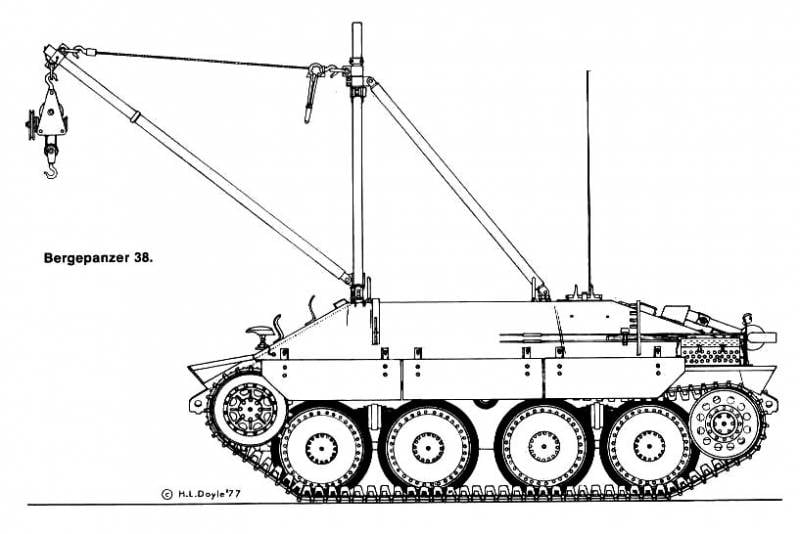
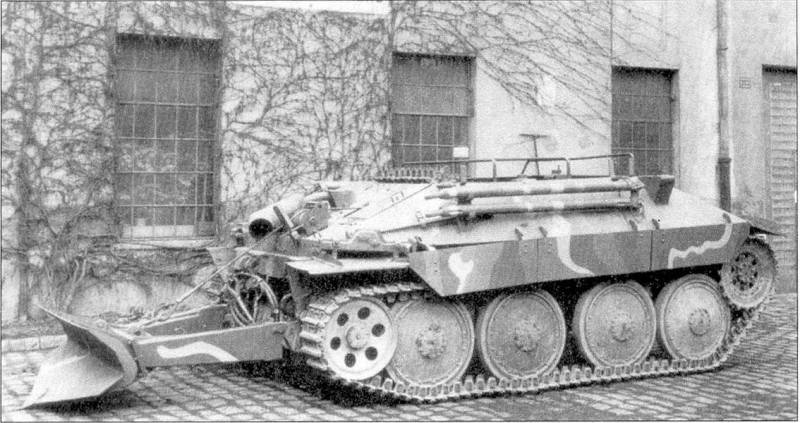
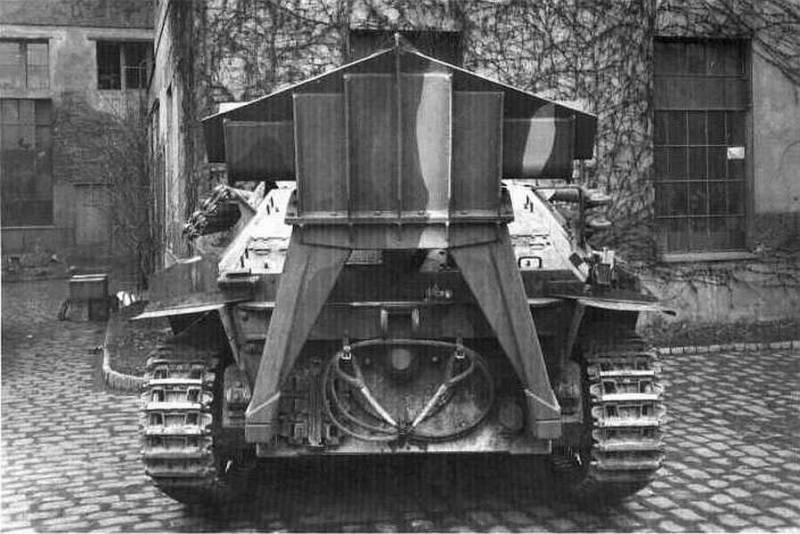
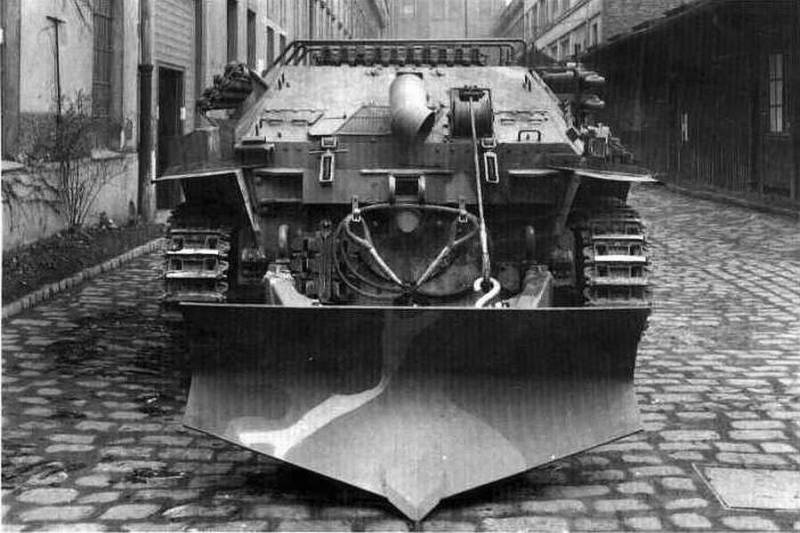
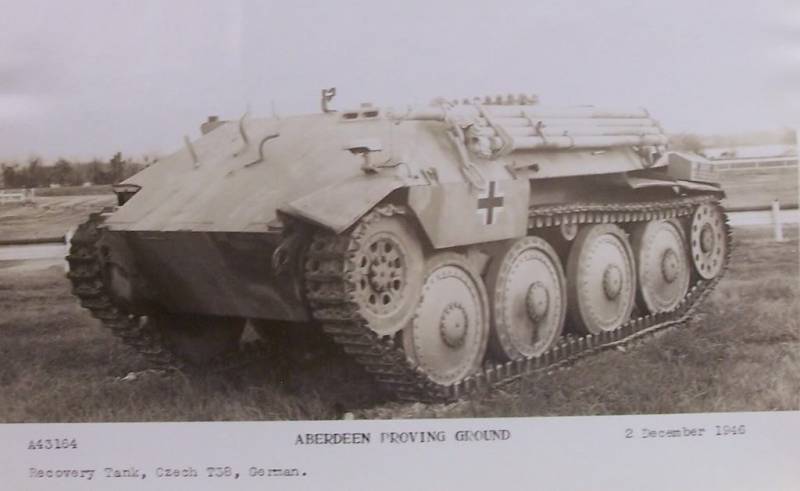
Information